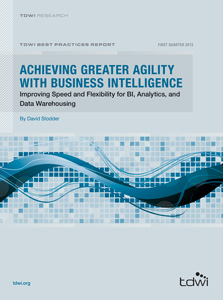
Executive Summary: Achieving Greater Agility with Business Intelligence
The information that flows from BI, analytics, and data warehousing systems can help organizations find the right decision-making balance that avoids the extremes of snap decisions and rigid processes. This new survey-based research report examines benefits, barriers, technology solutions, and recommendations for achieving greater agility with business intelligence.
- By David Stodder
- January 4, 2013
 Faster decision cycles, competitive pressures to seize fleeting opportunities, and the continuing need to adjust to upheavals in an interconnected global economy are driving demand for business intelligence and analytics that better support business agility. Organizations need flexibility; yet, even as some organizational structures are shifting to support fluid decision making and faster response to changing conditions, the BI systems that deliver vital data and provide the raw material for analytics are not keeping up.
Faster decision cycles, competitive pressures to seize fleeting opportunities, and the continuing need to adjust to upheavals in an interconnected global economy are driving demand for business intelligence and analytics that better support business agility. Organizations need flexibility; yet, even as some organizational structures are shifting to support fluid decision making and faster response to changing conditions, the BI systems that deliver vital data and provide the raw material for analytics are not keeping up.
Whether they are part of IT or business functions, professionals responsible for designing, developing, and deploying BI, analytics, and data warehousing (DW) systems are feeling the heat. Applications that merely give users one report after another are not adequate for agility. Professionals must shift development and deployment approaches so that systems are responsive to agile business needs and oriented toward providing self-service functionality to free users from dependence on IT. Self-service BI, however, must be part of a balance; data professionals must balance user freedom with data governance and the need for stable performance for all users.
This TDWI Best Practices Report focuses on how organizations can achieve greater agility with BI, DW, and analytics through adjustments in technology and development strategies. The report provides analysis of an in-depth research survey and user stories to reveal current strategies and future plans for achieving higher agility. The report offers recommendations for making flexibility, shorter time to value, and self-directed functionality higher priorities in BI, DW, and analytics.
Many leading organizations are implementing agile software development methods for BI, DW, and data integration systems. These methods form an alternative to traditional “waterfall” methods and cycles. Agile methods aim at closer collaboration between users and IT developers; they propose iterative cycles to deliver value incrementally rather than only at the end of full waterfall cycles. This report discusses agile method adoption.
Technology options are maturing to support agility as well. BI and data discovery tools now support self-directed data discovery and access to a broader array of data sources. Unified information access (UIA) tools and data integration middleware are bringing together the heretofore separate worlds of structured, semistructured, and unstructured data. Data virtualization is giving IT new options for providing faster access while also performing necessary profiling, quality, and governance steps on data as it is accessed from multiple sources. Mobile, cloud, and open-source options are providing better ways of delivering data and getting critical BI and analytics applications to users more rapidly.
It is an exciting time for organizations that have been frustrated with the slow pace of BI and DW development and concerned that the results are not delivering enough value and flexibility. Technology and development practices are evolving to support a world in which change, not stasis, is the constant.
Attivio, Informatica, Jaspersoft, MicroStrategy, SAP, Tableau Software, and WhereScape sponsored the research for this report.
About the Author
David Stodder is senior director of TDWI Research for business intelligence. He focuses on providing research-based insights and best practices for organizations implementing BI, analytics, data discovery, data visualization, performance management, and related technologies and methods and has been a thought leader in the field for over two decades. Previously, he headed up his own independent firm and served as vice president and research director with Ventana Research. He was the founding chief editor of Intelligent Enterprise where he also served as editorial director for nine years. You can reach him by email ([email protected]), on Twitter (twitter.com/dbstodder), and on LinkedIn (linkedin.com/in/davidstodder).